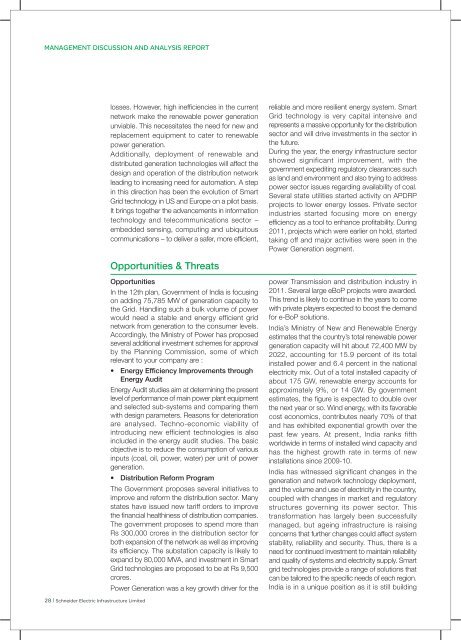Chairman
SEIL - Annual Report 2011 - Schneider Electric
SEIL - Annual Report 2011 - Schneider Electric
- No tags were found...
You also want an ePaper? Increase the reach of your titles
YUMPU automatically turns print PDFs into web optimized ePapers that Google loves.
MANAGEMENT DISCUSSION AND ANALYSIS REPORT<br />
losses. However, high inefficiencies in the current<br />
network make the renewable power generation<br />
unviable. This necessitates the need for new and<br />
replacement equipment to cater to renewable<br />
power generation.<br />
Additionally, deployment of renewable and<br />
distributed generation technologies will affect the<br />
design and operation of the distribution network<br />
leading to increasing need for automation. A step<br />
in this direction has been the evolution of Smart<br />
Grid technology in US and Europe on a pilot basis.<br />
It brings together the advancements in information<br />
technology and telecommunications sector –<br />
embedded sensing, computing and ubiquitous<br />
communications – to deliver a safer, more efficient,<br />
reliable and more resilient energy system. Smart<br />
Grid technology is very capital intensive and<br />
represents a massive opportunity for the distribution<br />
sector and will drive investments in the sector in<br />
the future.<br />
During the year, the energy infrastructure sector<br />
showed significant improvement, with the<br />
government expediting regulatory clearances such<br />
as land and environment and also trying to address<br />
power sector issues regarding availability of coal.<br />
Several state utilities started activity on APDRP<br />
projects to lower energy losses. Private sector<br />
industries started focusing more on energy<br />
efficiency as a tool to enhance profitability. During<br />
2011, projects which were earlier on hold, started<br />
taking off and major activities were seen in the<br />
Power Generation segment.<br />
Opportunities & Threats<br />
Opportunities<br />
In the 12th plan, Government of India is focusing<br />
on adding 75,785 MW of generation capacity to<br />
the Grid. Handling such a bulk volume of power<br />
would need a stable and energy efficient grid<br />
network from generation to the consumer levels.<br />
Accordingly, the Ministry of Power has proposed<br />
several additional investment schemes for approval<br />
by the Planning Commission, some of which<br />
relevant to your company are :<br />
• Energy Efficiency Improvements through<br />
Energy Audit<br />
Energy Audit studies aim at determining the present<br />
level of performance of main power plant equipment<br />
and selected sub-systems and comparing them<br />
with design parameters. Reasons for deterioration<br />
are analysed. Techno-economic viability of<br />
introducing new efficient technologies is also<br />
included in the energy audit studies. The basic<br />
objective is to reduce the consumption of various<br />
inputs (coal, oil, power, water) per unit of power<br />
generation.<br />
• Distribution Reform Program<br />
The Government proposes several initiatives to<br />
improve and reform the distribution sector. Many<br />
states have issued new tariff orders to improve<br />
the financial healthiness of distribution companies.<br />
The government proposes to spend more than<br />
Rs 300,000 crores in the distribution sector for<br />
both expansion of the network as well as improving<br />
its efficiency. The substation capacity is likely to<br />
expand by 80,000 MVA, and investment in Smart<br />
Grid technologies are proposed to be at Rs 9,500<br />
crores.<br />
Power Generation was a key growth driver for the<br />
power Transmission and distribution industry in<br />
2011. Several large eBoP projects were awarded.<br />
This trend is likely to continue in the years to come<br />
with private players expected to boost the demand<br />
for e-BoP solutions.<br />
India’s Ministry of New and Renewable Energy<br />
estimates that the country’s total renewable power<br />
generation capacity will hit about 72,400 MW by<br />
2022, accounting for 15.9 percent of its total<br />
installed power and 6.4 percent in the national<br />
electricity mix. Out of a total installed capacity of<br />
about 175 GW, renewable energy accounts for<br />
approximately 9%, or 14 GW. By government<br />
estimates, the figure is expected to double over<br />
the next year or so. Wind energy, with its favorable<br />
cost economics, contributes nearly 70% of that<br />
and has exhibited exponential growth over the<br />
past few years. At present, India ranks fifth<br />
worldwide in terms of installed wind capacity and<br />
has the highest growth rate in terms of new<br />
installations since 2009-10.<br />
India has witnessed significant changes in the<br />
generation and network technology deployment,<br />
and the volume and use of electricity in the country,<br />
coupled with changes in market and regulatory<br />
structures governing its power sector. This<br />
transformation has largely been successfully<br />
managed, but ageing infrastructure is raising<br />
concerns that further changes could affect system<br />
stability, reliability and security. Thus, there is a<br />
need for continued investment to maintain reliability<br />
and quality of systems and electricity supply. Smart<br />
grid technologies provide a range of solutions that<br />
can be tailored to the specific needs of each region.<br />
India is in a unique position as it is still building<br />
28 | Schneider Electric Infrastructure Limited







